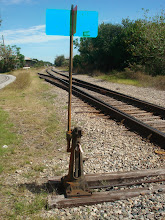I decided the original modules started for this project were too unstable at only 12" width. I set those aside and may reconfigure them for staging at some point in the future. The sides, ends, and plywood decks for these new modules have been cut for some time but other responsibilities have taken precedence. They are 15.75" before fascia is installed. This is slightly wider than the plans but since the tracks are centered on the modules I'm essentially just adding a little real estate to each side of the track. The overall length of each module is 48".
.JPG) Back to assembly. This photo shows the frame pieces and top deck for one module prior to assembly. The dimensions of the frame members were checked again for accuracy. The end plates were marked and then drilled with a countersink bit and attached to the side frame members using three 1.5" screws on each side ...6 total on each end. Once everything checked out with the dry assembly the end plates were removed and yellow carpenter's glue was used at each joint and the frame was reassembled making sure the joints were snug and the screw heads were sufficiently countersunk so as not to remain proud. This is important since the module ends will have to butt snugly once assembled.
Back to assembly. This photo shows the frame pieces and top deck for one module prior to assembly. The dimensions of the frame members were checked again for accuracy. The end plates were marked and then drilled with a countersink bit and attached to the side frame members using three 1.5" screws on each side ...6 total on each end. Once everything checked out with the dry assembly the end plates were removed and yellow carpenter's glue was used at each joint and the frame was reassembled making sure the joints were snug and the screw heads were sufficiently countersunk so as not to remain proud. This is important since the module ends will have to butt snugly once assembled.The plywood tops were about 1/16" too long once the frames were assembled so I used a sacrficial fence on my table saw so I could shave just a bit off each for an exact fit. The plywood was then dropped into place and attached with screws along each edge. The plywood tops rest on the side frames and between the end plates. Once these steps were completed I sanded all sides, ends, and edges to eliminate any rough or sharp edges.
The next step was to build legs for the modules. I had previously ripped some 1 inch stock into 1.5" x 47 " strips for the legs. I had some 7/16" plywood so I decided to use that for the spreader plates for the leg assemblies. I carefully measured the inside dimensions of the modules and cut the plates that width and just deep enough to slip up inside the module end plates between the side pieces. I assembled them to the legs with 1" screws. I plan to use bolts through the spreaders and end plates to attach the leg sets to the modules. Where two modules join the bolts will also hold the end plates together between the leg sets. I used this method on a previous modular layout with great success so am sticking to methods that have proven successful for me. I also ripped a smaller spreader plate to use at the bottom of each leg set. It's top edge is 10" from the bottom of the leg. I wanted something far enough down the leg to help maintain rigidity but also be far enough off the floor to allow the top to be used as a shelf support so a shelf can be used to store boxes and other items under the layout when it is set up.
.JPG) Once the legs were complete for the first two modules I clamped them in place to see how they looked and the result is shown in this photo. The new wider modules and their leg sets are remarkably sturdy and stable ...especially once joined with each other. I expect the corner module will add even more stabuility to the layout. I couldn't resist getting out my research notebook along with a couple of cars and turnouts to check dimensions and start getting a feel for the overall layout of track, structures, etc.
Once the legs were complete for the first two modules I clamped them in place to see how they looked and the result is shown in this photo. The new wider modules and their leg sets are remarkably sturdy and stable ...especially once joined with each other. I expect the corner module will add even more stabuility to the layout. I couldn't resist getting out my research notebook along with a couple of cars and turnouts to check dimensions and start getting a feel for the overall layout of track, structures, etc.Now to get the remaining two modules framed!
.JPG)
.JPG)
.JPG)
.JPG)
.JPG)
.JPG)
.JPG)
.JPG)
.JPG)
.JPG)

.JPG)
.JPG)
.JPG)
.JPG)
.JPG)
+(Medium).JPG)
